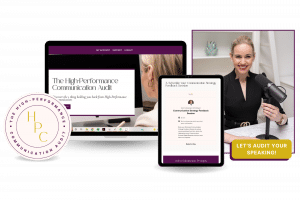Social Intelligence
How to Successfully De-escalate an Angry Customer or Client
Learn how to turn an angry customer into a super fan and feel comfortable in the process using your communication skills.

There’s no way to avoid angry customers, or conflict at work, especially if you’re in a product or service-based business. So today, we’re going to talk about how to turn an angry customer into a super fan and feel comfortable in the process using your communication skills.
As a full disclaimer, despite running a business for nearly ten years, I’ve had minimal customer conflict, less than 1% and may it continue that way. Still, as an executive speaking consultant, I frequently work with business owners, managers and team leaders to build up their responses to client conflict and their organisation’s policies that allow for a luxe customer experience.
So, this blog is for you if you’ve just found yourself in a difficult situation with a customer, client or even stakeholder. While this post was prepared with tips to help you handle tricky customer situations, many of the strategies can be used for any conflict in a professional environment.
This blog post is best digested in 3 parts:
- Check the tips below.
- Watch the vlog for more detailed training.
- If you want to get a firmer grip on your delivery, speaking style and trust building when it comes to with difficult conversations at work, our High-Performance Communication Audit will give you deep insight into areas we can level up to expand your communication and presenting skills for entrepreneurship.
Angry customers will pique any business owner’s fear, and the risks can be high if you cannot resolve conflict with your clients or stakeholders. Not only is your brand and reputation at stake, but the outcomes of a controversial customer experience can also lead to:
- Negative word of mouth
- Brand Reputation issues
- Staff- roles with high customer complaints tend to have lower retention. If your organisation frequently experiences customer disputes, your team will inevitably consider an imminent professional exit. You can prevent this is you roll out a tight strategy to reduce the emotional labour your staff must endure when faced with disappointed customers
- Leadership reputation impacts- leaders who fail to provide sufficient support and protection to team members continually faced with demanding clients are less likely to maintain their leadership credibility.
No doubt the negative impacts of displeased customers outlined above are all top of mind for you, but what about the positive opportunities that can arise from successful conflict repair? In many cases, it will be possible to restore trust in your product, services and reputation if you take intentional actions.
Here are some ideas to get you started!
10 Tactics that can turn an angry customer into a super fan and make you feel more comfortable in the process.
#1 Build up self-regulation skills.
When we’re engaged in a conflict, it’s normal to experience rushes of stress hormones resulting in unexpected emotional reactions. But no matter what someone says to you and how abrasive it is, you can learn to self-regulate and decompress.
These strategies are usually based on social intelligence training which will enhance your ability to take what you’re hearing, seeing or experiencing around you with levity so that you can deliver a calmer tactical response that is authentic, organic, and much more comfortable.
If you find yourself erupting internally when faced with conflict at work, you’ll want to focus on looking at ways in which you might want to build up your self-regulation skills. And if you’ve got questions about how to do this, you can always get in touch with us.

#2 Create a protocol to manage the emotional labour that results from angry customers.
Setting up a protocol in your organisation is vital if staff members frequently encounter demanding customers. If you’re a team leader, your team should know what to do when faced with difficult customers, and importantly as a leader, you need to offer support for their development in this area and advocate for coping mechanisms they can use.
If you’re on the front line dealing with challenging customers, form a protocol that enables you to refresh and decompress. This protocol will outline a set of coping strategies for you to deploy after a conflict occurs so that you can move out of the anger zone and redirect yourself by refreshing yourself, possibly with an activity that you know calms you down. For example, research shows that when people walk at a brisk, comfortable pace, they feel more confident and relaxed and even solve problems better. Find what works best to manage and realign your internal calm after a heated discussion. I’m sure there’s something unique to you that will be the best way to decompress.
#3 Brand out your professional language tone guide, especially for angry clients.
Here’s a novel but tried and tested resource directly from the toolkit of CADENZA! One of the most valuable approaches I take with Executives, CEOs and founders facing conflict management issues is to build out their professional language tone guide.
You may not have heard of this kind of resource before because this is a prototype document I’ve developed based on communication science research. I recommend you engage a communications expert to establish a modus operandi by which you encounter, reflect, and respond to conflict.
My Professional Tone Playbook will help you map out the parameters needed to calibrate goals around your speaking tone, speech pace, voice quality, soft skills, language style and how you’ll position your responses when faced with conflict.
If we don’t have a playbook ready for conflicts when they happen unexpectedly, how can we develop an elegant, let alone professional, response? So I strongly recommend that you map out a tone playbook.
I work individually with my clients in executive consulting sessions to clarify their rules of play in conversation. Still, it’s also delivered to my clients in the C-Suite, an entire year-long communication program that optimises your professional speaking to enhance communication success and leadership presence at work. Learn more about how to work with us here.
#4 Create a solution pathway for hypothetical conflicts so you can be ready to respond seamlessly to the next angry customer.
If you’re delivering services and products, it’s good to hypothesise what would be the worst thing that could possibly go wrong and then reverse engineer a solution pathway to benefit your customer experience journey. When we respond to conflict, client frustration and weak customer experience, we must take a course of action to restore client trust or a relationship that mitigates business risk. And the best way to re-engage trust with our clients, if they’re feeling disappointed with some aspect of our services or products is to undertake an action indicating that we genuinely care about their concern. When our course of action attempts to address our respect for the customer with effort and energy, even if their ideas and perspective of the service are slightly different from ours, we will be more successful at restoring the relationship.
#5 Prioritise communication pathways that show action to restore trust fast.
When your client is frustrated and annoyed, you’re dealing with a breach of trust, not just their disappointment. So, despite your best efforts and intentions, for whatever reason, your client feels like something didn’t stack up, they’re disappointed and didn’t get the expectations they had in your services, and they lost trust in you, your brand or services. In this instance, you need to think about prioritising communication pathways that show action intent on creating tangible solutions for your client.

#6 Even if your angry customer sounds illogical, there is always a logic behind their grievance, and the sooner you can understand it, the better.
Take time to identify the customer’s logic behind the grievance while you listen to their verbal outpouring. If someone gets into an aggressive verbal attack with you in a customer experience, it’s typical to feel all the feelings and overlook the conversation’s analytical priorities.
While you listen, please don’t focus on their emotions only. Start to hypothesise with these questions:
- What is the client’s perspective?
- What is the logic that’s driving this breakdown in the experience?
- What’s their motive?
It’s always good to hope for the best with your customer, especially if you want to restore the customer experience, repair their broken expectations, and reach an amicable solution.
But to grasp their logic, you need to reposition your attention instead of focusing on their feelings and only making emotion-based observations (such as – “I can’t believe they’re saying that” or “This person is so rude”) and get more analytical. This cognitive approach will usually increase your chance of self-regulation, giving you the headspace you need to respond with practical solutions for your customer and decompress.
#7 Never over promise to any customer, especially an angry one.
When a customer is incredibly disappointed with what they expect, most of my clients are tempted to over-promise and deliver a solution that lies outside their scope.
When a client registers sheer disappointment with a service or product, or customer experience that they’ve had, the challenge is to resist the urge to deliver an excessive solution to make ends right.
But take care that you’re not delivering solutions in a brash, hasty way that might sit outside your scope, workflow or organisational policy and procedures. Solutions must promise the possible, or you’ll face even more anger from your client, especially if you must retract a big promise.
Better still, offer the minimum option that could satisfy the customer’s logic because then you can always step it up; if you see that their frustration is accelerated, you have something else to offer to diffuse them.
Here we’re not talking about doing the minimum for our clients; we should always do the best. But in a situation of customer repair and trust repair, give a feasible promise you can meet. And then you can always step up an even more attractive and unexpected offer after the exchange. In addition, post-conflict repair in customer experience tends to encourage increased word of mouth and an ongoing relationship, according to customer experience research.

#8 Learn to build ironclad rapport with difficult people.
Everyone has a different definition of a difficult person, and no one thinks they are it!
Remember that you can learn to build ironclad rapport. It is always something that you should always strive to do. We can’t just have a connection with people we like and write off everyone else. I mean, sure, it’s easy, and it feels nice to hang and kick back and have conversations with our likeable friends who we like and maybe have great engagement with our customers with whom we feel a resonance. But we also need to build rapport with people with a slightly different temperament from us and who see things differently. Because in business, in our roles, we will always encounter different personalities. And while there is an argument to put up a system to ensure that you’re getting the ideal client, the client will benefit from your services. At times, people get through the cracks, and you may find yourself with the not-so-ideal client for your services or your personality, and you’ll need to work through that because that’s what being a professional communicator is all about.
Remember, in a conflict; it’s never a competition for who is right. It’s always an opportunity, as a professional speaker, to build ironclad rapport. I like to remind myself that conflict is always an opportunity and opportunity to learn more about your clients and your position in the market, your client’s needs, and how well your product, your services, or even your organisational processes and communication stack up.
#9 Hear the complaint out before you judge it and react to it.
Most people know that when they’re in a conflict, to listen and let the customer speak. But I strongly encourage you to hear the complaint before you judge it. Not all complaints will be valid. That’s right. But it’s imperative to listen to hear it out. And while you’re listening, analyse the logic, and don’t take a point of judgement; reflect on the logic of the customer instead and try to see their perspective, which leads me to our final tactic for you to deploy in a customer-based conflict so that you can turn an angry customer into a superfan and feel comfortable in the process.
#10 Empathy for your angry client is a process of hypothesis.
In customer conflict, take care not to showcase that you understand exactly how your customer is feeling; this can be very condescending because you’re not going through the problem they are facing. You’re not experiencing it, and possibly you’re the person who potentially, in the client’s eyes, caused the problem. Therefore, avoid making statements like:
“Yeah, I know what you mean.”
“I understand how you feel.”
Such statements can be very abrasive for your client because they are likely to hold a rationale that makes them think something along the lines of “
“Yeah. Okay. So if you understand how I feel, why did you make a mistake or let me down?”
Empathy in this scenario is best practice when you take the time to enact the true definition of empathy, which is to imagine the other person’s perspective.

By now, if you’re reflecting on past conflicts with angry clients and you’ve felt that your client was still tricky after you thought- “I was nice to them, I handled that well, I showed that I understood how they felt”, take care! No doubt you failed to apply empathy correctly in the scenario, and in declaring that you understood them entirely and knew how they felt, chances are; this is why you saw your customer get even angrier. So avoid showcasing that you know what they feel because they don’t want to hear how well you understand their feelings; they want to hear a solution.
Today we worked through 10 tactics in total that you’ll want to consider if you’re in the hot seat with customers, clients or contacts.
I can provide many more research-based supports if you’d like to take this further, so check out the resources on this, get in touch, or better still, take action today to turn up your communication success with the High-Performance Communication Audit.

References
- Tao, K., et al. (2016). “How Angry Customer Complaints Influence Salesperson Commitment to Service Quality.” Journal of Marketing Theory and Practice 24: 265-282.
Did you enjoy this post? Make sure to subscribe to our YouTube channel to get more content to increase your communication skills!
About the Author
Dr Sarah Lobegeiger de Rodriguez is a Keynote Speaker, Executive Speaking Coach, and Opera Singer who likes to play with words, sounds, and your impact.
Her academic background is in Music Performance, Communication Science and Speech & Language Pathology. She assists executive communication clients all over the world as a communication consultant with strong expertise in CEO, Founder and Entrepreneur communication strategies.
Connect with Sarah on LinkedIn.
© CADENZA
Level 14, 380 St Kilda Road, Melbourne, 3004
Privacy Policy
Terms & Conditions
Position Statement on Racism


